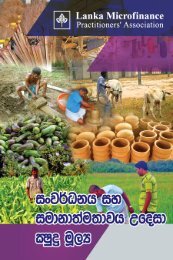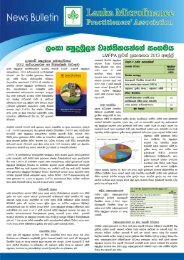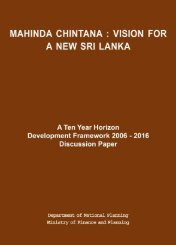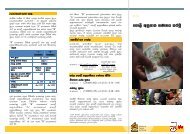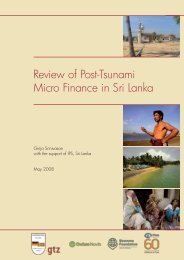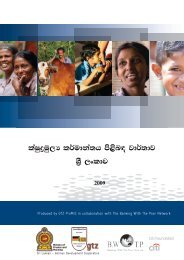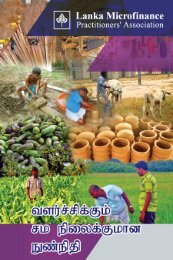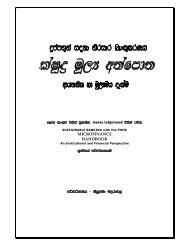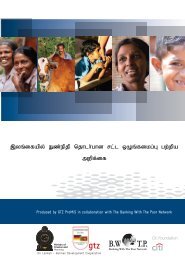National Microfinance Study of Sri Lanka: Survey of Practices and ...
National Microfinance Study of Sri Lanka: Survey of Practices and ...
National Microfinance Study of Sri Lanka: Survey of Practices and ...
Create successful ePaper yourself
Turn your PDF publications into a flip-book with our unique Google optimized e-Paper software.
Introduction<br />
Socio-Economic Overview<br />
<strong>Sri</strong> <strong>Lanka</strong>’s population is estimated at between 18.73 million <strong>and</strong> 19.4 million<br />
depending upon whether one includes citizens living abroad or not. The<br />
preliminary estimates <strong>of</strong> the 2001 national census estimate a total population <strong>of</strong><br />
18.73 million. However, for the purposes <strong>of</strong> this study we have assumed a total<br />
population <strong>of</strong> 18.77 million 6 as it was necessary to calculate population on a<br />
district-by-district basis prior to the release <strong>of</strong> the total census estimates.<br />
The average annual growth rate for the period 1984 to 2001 is estimated to be<br />
1.14 percent. This growth rate is well below that <strong>of</strong> most countries in the South<br />
Asia region <strong>and</strong> is largely due to the combination <strong>of</strong> an ageing population <strong>and</strong><br />
overall improvement in livings conditions (Census, 2001).<br />
<strong>Sri</strong> <strong>Lanka</strong> has been in the process <strong>of</strong> liberalising its economy for a quarter <strong>of</strong> a<br />
century, but still has some way to go. The economy has grown at a rate <strong>of</strong> five<br />
percent in real terms over the last decade. This growth is largely due to reasonable<br />
macroeconomic management <strong>and</strong> progress in trade liberalisation, privatisation,<br />
<strong>and</strong> financial sector reform.<br />
Trade accounts for more than seventy percent <strong>of</strong> GDP <strong>and</strong> <strong>Sri</strong> <strong>Lanka</strong> is South<br />
Asia’s most open economy. It has a relatively developed capital market<br />
infrastructure <strong>and</strong> a per capita income <strong>of</strong> US$ 841 in 2000, equating to about US$<br />
2,500 on a purchasing power parity basis. However, the public sector continues to<br />
dominate the financial l<strong>and</strong>scape with per capita employment in the public sector<br />
being the largest in Asia (CBSL, 2001).<br />
It is generally recognised that "In terms <strong>of</strong> human development <strong>Sri</strong> <strong>Lanka</strong> is ahead<br />
<strong>of</strong> other countries with similar economic development status. Literacy levels,<br />
access to basic health care <strong>and</strong> access to education are all well above South Asia<br />
averages." (CARE, 2000).<br />
However, <strong>Sri</strong> <strong>Lanka</strong>'s development continues to remain below its potential <strong>and</strong><br />
the secessionist conflict has exacted a heavy price on the country’s overall<br />
performance <strong>and</strong> poverty persists in the North <strong>and</strong> East region, the tea plantations<br />
<strong>and</strong> pockets in dry zone areas <strong>and</strong> urban slums (c.f. S<strong>and</strong>eratne, 2000; Kahn,<br />
2001).<br />
6 According to the 2001 <strong>National</strong> Census (including Ampara), the Government Agent Office’s in<br />
the North & East Districts (Batticaloa, Jaffna, Mannar, Trincomalee <strong>and</strong> Vavuniya) <strong>and</strong> the<br />
estimates <strong>of</strong> local authorities in the Wanni Area, the total population <strong>of</strong> <strong>Sri</strong> <strong>Lanka</strong> is estimated at:<br />
16,864,544; 1,582,000; <strong>and</strong>, 328,000, respectively, giving a total national population estimate <strong>of</strong><br />
18,774,544 people. According to the 2001 <strong>National</strong> Census, the average family size is estimated at<br />
5.6 people.<br />
35




